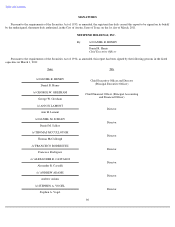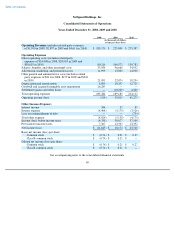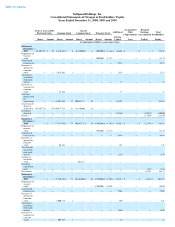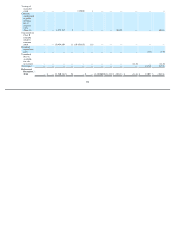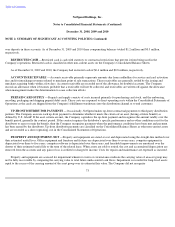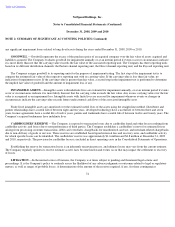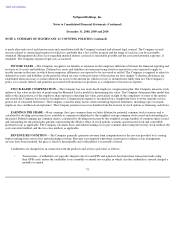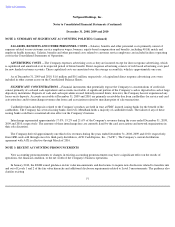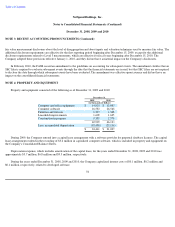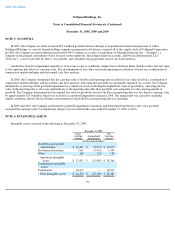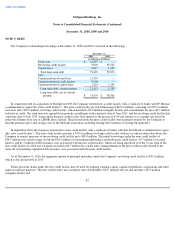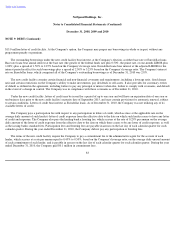NetSpend 2010 Annual Report Download - page 79
Download and view the complete annual report
Please find page 79 of the 2010 NetSpend annual report below. You can navigate through the pages in the report by either clicking on the pages listed below, or by using the keyword search tool below to find specific information within the annual report.
Table of Contents
NetSpend Holdings, Inc.
Notes to Consolidated Financial Statements (Continued)
December 31, 2008, 2009 and 2010
NOTE 2: SUMMARY OF SIGNIFICANT ACCOUNTING POLICIES (Continued)
over deposits in these accounts. As of December 31, 2009 and 2010 these compensating balances totaled $1.2 million and $0.3 million,
respectively.
RESTRICTED CASH —Restricted cash is cash with statutory or contractual restrictions that prevent it from being used in the
Company's operations. Restricted cash is classified in other non-current assets on the Company's Consolidated Balance Sheets.
As of December 31, 2009 and 2010, the Company had restricted cash of $0.4 million and $0.8 million, respectively.
ACCOUNTS RECEIVABLE —Accounts receivable primarily represents amounts due from cardholders for service and card activation
fees and for interchange revenues related to merchant point of sale transactions. These receivables are generally settled by the issuing and
merchant acquiring banks within a few days. Accounts receivable are recorded net of the allowance for doubtful accounts. The Company
records an allowance when it becomes probable that a receivable will not be collected, and receivables are written off against the allowance
when management makes the determination to cease collection efforts.
PREPAID CARD SUPPLY —Prepaid card supply consists of costs incurred primarily for purchasing card stock, and the embossing,
encoding, packaging and shipping prepaid debit cards. These costs are expensed to direct operating costs within the Consolidated Statements of
Operations as the cards are shipped from the Company's fulfillment warehouses into the distribution channel or to end customers.
UP-FRONT DISTRIBUTOR PAYMENTS —Occasionally, NetSpend makes up-front contractual payments to third-party distribution
partners. The Company assesses each up-front payment to determine whether it meets the criteria of an asset (having a future benefit) as
defined by U.S. GAAP. If the asset criteria are met, the Company capitalizes the up-front payment and recognizes the amount ratably over the
benefit period, generally the contract period. If the contract requires the distributor's specific performance and no other conditions exist for the
distributor to earn or retain the benefit, then the Company recognizes payments when the performance conditions have been met and payment
has been earned by the distributor. Up-front distributor payments are classified on the Consolidated Balance Sheets as other non-current assets
and are recorded as a direct operating cost in the Consolidated Statements of Operations.
PROPERTY AND EQUIPMENT, NET —Property and equipment are stated at cost and depreciated using the straight-
line method over
their estimated useful lives. Office equipment and furniture and fixtures are depreciated over three to seven years, computer equipment is
depreciated over three to five years, computer software is depreciated over three years, and leasehold improvements are amortized over the
shorter of their estimated useful life or the term of the related lease. When assets are sold or retired, the cost and accumulated depreciation are
removed from the accounts and any gain or loss is credited or charged to income. Costs for repairs and maintenance are expensed as incurred.
Property and equipment are assessed for impairment whenever events or circumstances indicate the carrying value of an asset group may
not be fully recoverable by comparing the carrying value to total future undiscounted cash flows. Impairment is recorded for long-lived assets
equal to the excess of the carrying amount of the asset group over its estimated fair value. The Company did not recognize
73



